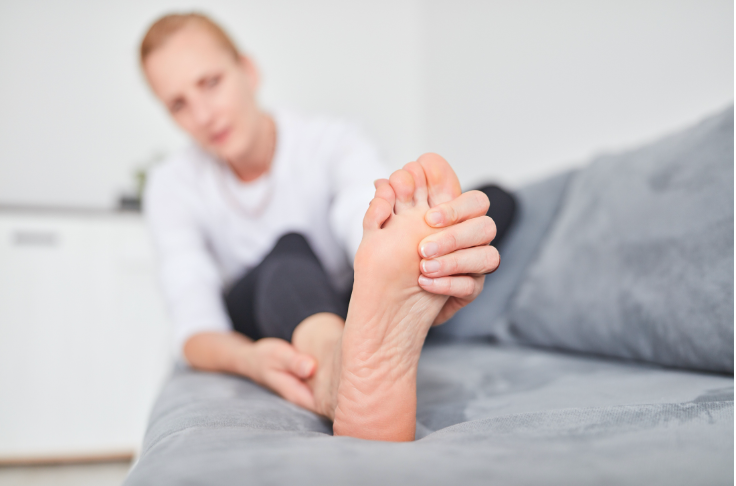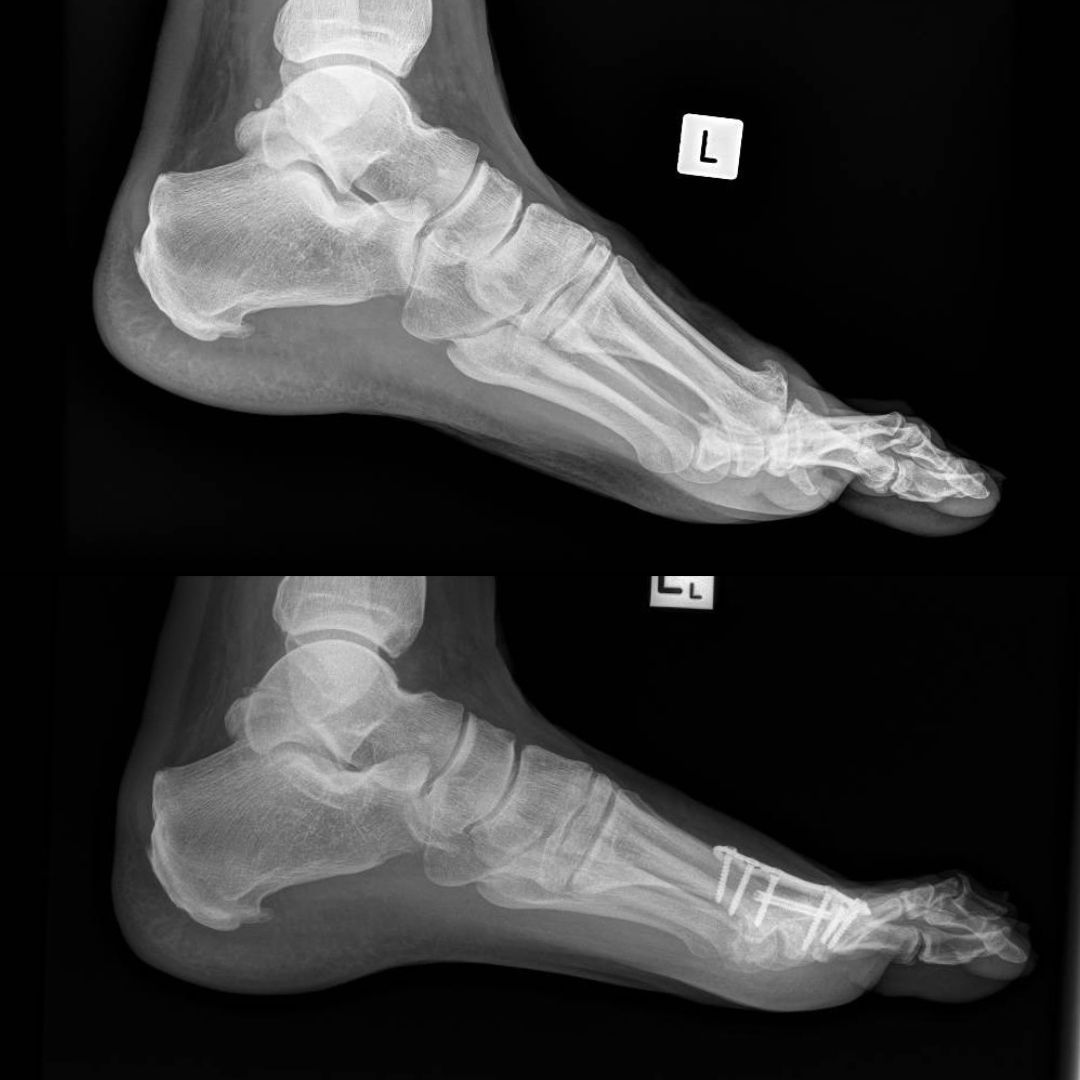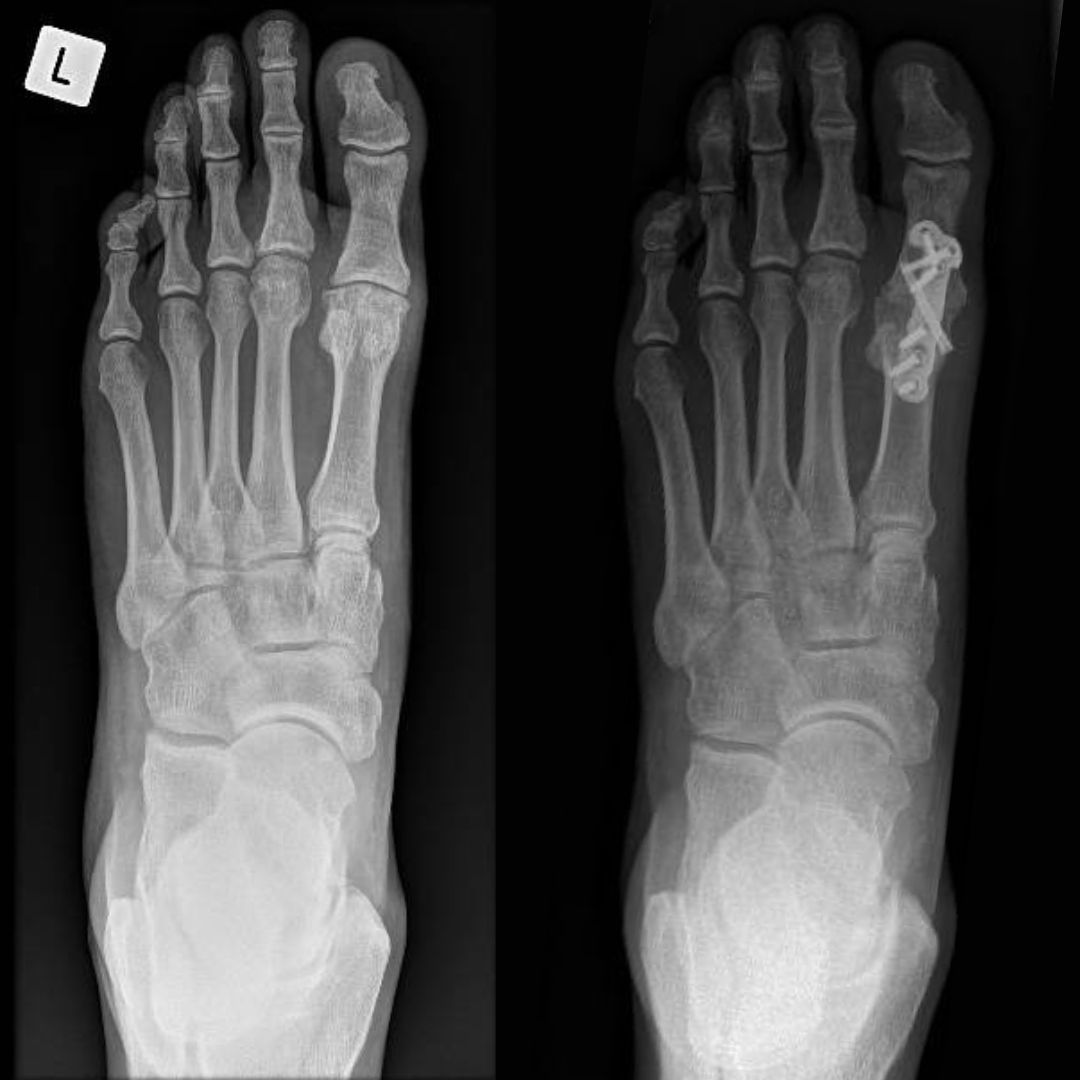Hallux Rigidus
What is Hallux Rigidus?
Hallux rigidus is arthritis at the base of the big toe in the metatarsophalangeal joint (MTPJ). Like most joints, the ends of the bones are covered by smooth cartilage called articular cartilage. If this cartilage wears away, it can cause arthritis of the joint. A bone spur called an osteophyte can form, decreasing big toe movement. If all the cartilage wears away, the bone rubs against the bone, which can cause pain and stiffness.

Impact of Hallux Rigidus on Anatomy and Health
- Anatomy:
- The metatarsophalangeal joint becomes stiff due to cartilage wear, bone spurs, or inflammation.
- Decreased flexibility in the big toe affects foot mechanics, often leading to compensatory walking patterns.
- Health:
- Pain and stiffness can limit physical activity.
- Altered gait mechanics may lead to secondary issues like knee, hip, or lower back pain.
- Severe cases may restrict daily activities, affecting overall quality of life.
Risk Factors for Hallux Rigidus
- Poor foot alignment, such as hallux valgus or flat foot
- Traumatic injury to the big toe
- Inflammatory conditions such as gout and rheumatoid arthritis
Causes of Hallux Rigidus
Hallux rigidus is often caused by wear and tear over time, like most joint arthritis. A genetic predisposition or a previous injury can also contribute to or accelerate the wear and tear.
Symptoms of Hallux Rigidus
- Pain in the big toe joint (just at the base of the big toe), often during or after walking and activity
- Stiffness of the big toe (harder to move it up and down)
- Swelling around the big toe joint
- A bump or deformity just at the base of the big toe
Prevention of Hallux Rigidus
- Footwear: Wear supportive shoes with a wide toe box and rigid sole. Avoid high heels and shoes that put pressure on the big toe.
- Activity Modification: Reduce repetitive stress on the toe by alternating activities. Use proper techniques during sports or exercise.
- Maintain a Healthy Weight: Reducing body weight minimises stress on foot joints.
- Stretching and Strengthening: Regular toe and foot exercises improve joint flexibility and strength.
- Early Intervention: Address foot pain or structural issues promptly to prevent progression.
- Custom Orthotics: Use inserts or insoles to reduce stress on the big toe joint.
Types of Hallux Rigidus
Hallux rigidus is typically categorised into two types based on its cause and presentation:
- Primary Hallux Rigidus:
- Caused by degenerative arthritis due to wear and tear in the big toe joint.
- Commonly associated with aging or repetitive use.
- Secondary Hallux Rigidus:
- Results from other conditions such as trauma, inflammatory arthritis (e.g., rheumatoid arthritis, gout), or congenital deformities.
- May occur in younger individuals or those with predisposing medical conditions.
Stages of Hallux Rigidus
Hallux rigidus progresses through four stages:
- Stage 1 (Mild):
- Minimal cartilage loss and joint damage.
- Slight pain or stiffness during certain activities, with normal joint range of motion.
- Stage 2 (Moderate):
- Increased cartilage loss and noticeable joint narrowing.
- More frequent pain and reduced joint motion, especially during activities.
- Early bone spurs may develop.
- Stage 3 (Severe):
- Significant cartilage destruction with prominent bone spurs.
- Severe pain even during rest, with greatly restricted joint motion.
- Stage 4 (End-Stage):
- Complete cartilage loss with "bone-on-bone" contact.
- Constant pain and almost total immobility of the big toe joint.
Diagnosis of Hallux Rigidus
Hallux rigidus can usually be seen on X-rays. In mild or early cases, an MRI may be required to help diagnose it.
Management and Treatment of Hallux Rigidus
Treatment aims to relieve pain in the big toe. This can include:
- Shoes: Shoes with a wider toe box ease pressure over the painful area. Shoes with stiff soles also help by limiting movement of the painful area during walking. Avoiding high heels will also help relieve pain.
- Orthotics: A rigid big toe extension in the shoe or supporting padding may be available through the chemist or the podiatrist
- Medications: Paracetamol and/or ibuprofen (anti-inflammatory medications) can help with pain during acute periods.
- Injections: Steroid injections can provide relief from pain but do not change the underlying problem
- Surgery: If the measures above are not helping with pain, surgery can be performed to help.
If you want an opinion on this condition, please book an appointment with Dr Christy Graff.


What if Hallux Rigidus is Untreated?
Without treatment, hallux rigidus can lead to:
- Progressive Joint Damage:
- Increased stiffness and pain over time.
- Potentially leading to complete immobility of the big toe.
- Altered Gait:
- Compensatory walking patterns may cause pain in the ankles, knees, hips, or lower back.
- Chronic Pain:
- Persistent pain can significantly impair quality of life and physical activity.
- Deformities:
- Development of bone spurs, bunions, or secondary foot deformities.
Early diagnosis and intervention can help manage symptoms and slow progression, improving overall outcomes.
